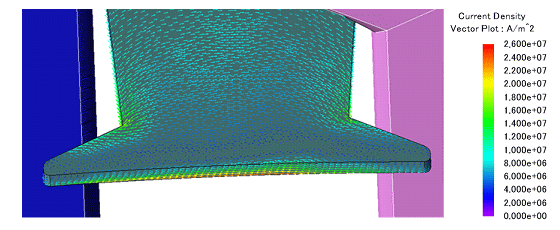Contents
1. Overview
2. Issues in motor eddy current analysis
3. Large scale model solution
4. Example of motor eddy current analysis at high rotation speed
5. Improving speed with parallel processing
6. Summary
7. References
1. Overview
To accurately obtaining the end-winding eddy current loss at high rotation speed, the influence of the magnetic field flux generated by the eddy current flow in every part of the machine cannot be ignored. Therefore, there is a need for considering the eddy currents of multiple parts simultaneously. However, the larger sizes of the model and its calculation times can be an obstacle to performing such analysis. For this, the use of a highly parallel processing environments is necessary. This allowed obtaining accurately the eddy currents at every location of the machine. Furthermore, we confirmed that the obtained eddy current loss improved the accuracy of both the loss values and the efficiency map of the machine. Additionally, the mesh modelling for this kind of eddy current calculation will be discussed.
2. Issues in motor eddy current analysisw
The drive for smaller, more powerful and efficient drive motors, makes the reduction of the loss indispensable. The end-winding AC loss and iron loss constitute a large proportion of the total loss of the machine, requiring special attention when designing a machine. Generally, the end-winding steel sheet lamination’s interior surface eddy current loss makes up only a small percentage of the total losses. However, in analyses where high accuracy is desired, this phenomenon cannot be ignored. When magnetic field’s frequencies are high, like at high rotation speeds, there is a concern that the magnetic fields generated by the eddy currents may affect the analysis accuracy. Moreover, the combination of the magnetic field due to the in-plane eddy current generated in the steel sheet, from the eddy current generated in the coil end winding, press ring and magnet will affect the flow of the magnetic flux. For this reason, running analyses ignoring the eddy currents will lead to modelling a magnetic flux flow that will differ from reality and result in a lack of accuracy in the analysis. Therefore, there is a need to consider the eddy current loss in every part of the machine simultaneously. However, those eddy current analysis require fine mesh division in all parts of the model leading to a large model size and a long calculation time.

IPM motor large-scale model with the eddy currents of each part analyzed simultaneously

Steel sheet outermost layer teeth eddy current distribution
You need to sign in as a Regular JMAG Software User (paid user) or JMAG WEB MEMBER (free membership).
By registering as a JMAG WEB MEMBER, you can browse technical materials and other member-only contents for free.
If you are not registered, click the “Create an Account” button.
Create an Account Sign in



